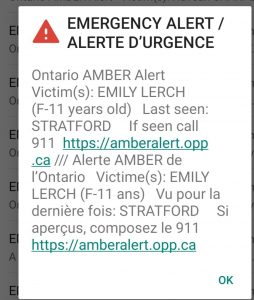 Enough is enough. Once again, we experienced another case of Canadian police forces’ use of the national public alert system.
Enough is enough. Once again, we experienced another case of Canadian police forces’ use of the national public alert system.
At 5:58pm Tuesday evening, I received another useless Amber Alert on my phone.
As described by the AlertReady website, some government issuer (in this instance, the Ontario Provincial Police), crafted a message to tell the public that an 11-year old girl was last seen in Stratford and we are to dial 911 or go to amberalert.opp.ca.
More than 6 hours earlier, Stratford Police tweeted far more descriptive information: “last seen around the Rotary Complex. 5′ tall, thin build, black top with Jurassic Park logo, black shorts, black shoes, glasses.”
Stratford Police are asking for help locating 11 year old Emily LERCH. Emily has been missing since this morning last seen around the Rotary Complex.
5' tall, thin build, black top with Jurassic Park logo, black shorts, black shoes, glasses.Call 911 if seen pic.twitter.com/SST9UulfKs
— Stratford Police Service (@SPSmediaoffice) August 2, 2022
Why did the Amber Alert message contain so little descriptive information, when clearly, so much more useful information was available?
Thankfully, Stratford Police issued a tweet at 6:26 pm identifying that the girl had been found, safe, apparently in York Region, around 100 miles away.
That explains why the OPP website from the Amber Alert was displaying a banner with “NO ACTIVE ALERTS” when I visited the site around 7:00pm. As I write this, the OPP has not yet cancelled the Amber Alert.
There are clear responsibilities for the issuer of a public alert:
- Specifies the type of alert [e.g. amber alert, tornado, etc.] as well as whether it is to be broadcast immediately because of imminent threat to life.
- Chooses the content of the message, including which language(s) the message will be issued in.
- Chooses the format of the message, including whether the message will be sent as text only, audio only or in both text and audio formats.
- Specifies why and when the alert is sent.
- Ensures that the alert is updated and/or cancelled.
- Specifies the geographical areas covered by the alert.
That York Regional Police were involved in the rescue demonstrates the value of casting a wide net for the geographical coverage of the alert, but we should not accept the lengthy delay between the local police force’s appeal to the public over social media and the OPP issuing an official alert. Above all, the lack of useful descriptive information in the Amber Alert is inexcusable.
For more than 3 years, I have been calling for “formal process to review each use of the National Public Alert System, to help develop best practices”
The AlertReady system is a powerful tool in the hands of Canada’s public safety officials. As I have written before, I don’t question that the system was deployed in this instance. Shouldn’t we continually be examining how the system was deployed, to ensure that it will always be used in the best possible manner?
In April, I described a review of the US system being undertaken by the FCC. I would prefer to see leadership of such a review by Public Safety officials, but it is clear that multiple agencies and multiple levels of government should take interest.
As I have said repeatedly, shouldn’t we continually be examining how the NPAS system is being deployed, to ensure that it will always be used in the best possible manner?
With continued failures in the way imminent threats are being communicated to the public, the safety of Canadians is being threatened.
Ottawa needs to take action to improve the way alerts are being transmitted.

Spot on. There is plenty of opportunity for improvement if there was the leadership.